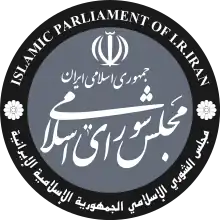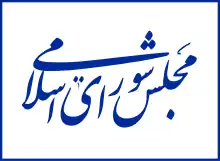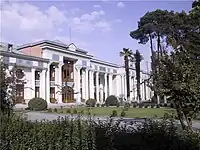Islamic Consultative Assembly مجلس شورای اسلامی Majles-e Showrā-ye Eslāmī | |
|---|---|
| 11th term | |
 | |
 | |
| Type | |
| Type | |
| History | |
| Founded | 16 November 1906 14 March 1980 (current form) |
| Preceded by | National Consultative Assembly |
| Leadership | |
Mohammad Bagher Ghalibaf since 28 May 2020 | |
First Vice | Abdolreza Mesri since 28 May 2023 |
Second Vice | Mojtaba Zonnour since 28 May 2023 |
| Structure | |
| Seats | 290[1] |
 | |
Political groups |
|
Length of term | 4 years[1] |
| Elections | |
| Qualified majority two-round system[1] | |
Last election | 21 February and 11 September 2020 |
Next election | 1 March 2024 |
| Meeting place | |
 | |
| Islamic Consultative Assembly Baharestan Tehran Iran | |
| Website | |
| https://en.parliran.ir/ | |
| Constitution | |
| Constitution of the Islamic Republic of Iran | |
 |
|---|
| Government of Islamic Republic of Iran |
The Islamic Consultative Assembly (Persian: مجلس شورای اسلامی, romanized: Majles-e Showrā-ye Eslāmī), also called the Iranian Parliament, the Iranian Majles (Arabicised spelling Majlis) or ICA, is the national legislative body of Iran. The Parliament currently consists of 290 representatives, an increase from the previous 272 seats since the 18 February 2000 election. The most recent election took place on 21 February 2020, and the new parliament convened on 28 May 2020.[2]
Founded in 1906 as the National Consultative Assembly, the ICA has been described as the rubber stamp parliament for the unelected Supreme Leader of Iran since the 1979 Iranian Revolution.[3]
History
Islamic Republic of Iran
Following the Iranian Revolution of 1979, the Senate of Iran was abolished and effectively succeeded by the Guardian Council, maintaining the bicameral structure of the Iranian legislature. In the 1989 constitutional revision, the National Consultative Assembly was renamed the Islamic Consultative Assembly.
Since the Iranian Revolution, the Parliament of Iran has been led by six chairmen. Akbar Hashemi Rafsanjani served as the inaugural chairman from 1980 to 1989. Subsequently, Mehdi Karroubi held the position in two separate terms (1989–1992 and 2000–2004), followed by Ali Akbar Nategh-Nouri (1992–2000), Gholam-Ali Haddad-Adel (2004–2008), Ali Larijani (2008–2020), and, since 2020, Mohammad Bagher Ghalibaf.
Throughout its history, the Parliament's character has evolved from being a "debating chamber for notables" to a "club for the shah's placemen" during the Pahlavi era. In the era of the Islamic Republic, it has shifted to being a body primarily influenced by members of the "propertied middle class."[4][5]
2017 attack
On 7 June 2017, there were shootings at the Iranian parliament and at the shrine of Ayatollah Khomeini.[6] Gunmen opened fire at the Iranian Parliament and the mausoleum of religious leader Ayatollah Khomeini in Tehran. The attack on the mausoleum reportedly left 17 persons dead and more than 30 people injured. The parliament was attacked by four gunmen which left seven to eight people injured. Both attacks took place around the same time and appear to have been coordinated.
Functions
The Islamic Consultative Assembly holds the authority to legislate laws on all matters within the boundaries defined by the Constitution.[7] Nevertheless, it is restricted from enacting laws that contradict the fundamental principles of the official religion of the nation (Islam) or the Constitution itself.[8]
Government bills are submitted to the Islamic Consultative Assembly only after obtaining the approval of the Council of Ministers.[9]
The Islamic Consultative Assembly possesses the prerogative to investigate and scrutinize all matters concerning the country.[10]
International treaties, protocols, contracts, and agreements necessitate approval from the Islamic Consultative Assembly.[11]
Sanctioning and obtaining national or international loans or grants by the government requires ratification from the Islamic Consultative Assembly.[12]
The President must secure a vote of confidence from the Assembly, through a Council of Ministers approval, upon forming the government and prior to conducting any other business.[13]
In the event that at least one-fourth of the total members of the Islamic Consultative Assembly raise a question to the President, or if any Assembly member poses a question to a minister regarding their duties, the President or the minister is obligated to attend the Assembly and address the query.[14]
All legislation endorsed by the Islamic Consultative Assembly must be submitted to the Guardian Council. Within a maximum of ten days from its receipt, the Guardian Council must review the legislation to ensure its compatibility with Islamic criteria and the Constitution. If any incompatibility is identified, the legislation is returned to the Assembly for further review. Otherwise, the legislation is deemed enforceable.[15]
Election
People need to sign up online and upload their university degree document. Volunteers need to be 30 at least and 75 years maximum, have a Masters degree or equal Level 3 Islamic seminary, and be Iranian born.[16]
Membership

Currently, there are 290 members of Parliament, elected for a four-year term. There are five seats reserved for religious minorities (1.7% of the total members), with two for the Armenians and one each for the Assyrians, Jews and Zoroastrians. MPs are popularly elected for four-year terms. About 8% of the Parliament are women, while the global average is 13%.[17]
The Parliament can force the dismissal of cabinet ministers through no-confidence votes and can impeach the president for misconduct in office. Although the executive proposes most new laws, individual deputies of the Parliament also may introduce legislation. Deputies also may propose amendments to bills being debated. The Parliament also drafts legislation, ratifies international treaties, and approves the national budget.
All candidates running for election, and proposed legislation from the assembly must be approved by the Guardian Council. Candidates must pledge in writing that they are committed, in theory and in practice, to the Iranian constitution.
Constituencies
The Parliament currently has 207 constituencies, including the 5 reserved seats for religious minorities. The remaining 202 constituencies are territorial, each covering one or more of Iran's 368 counties.
Leadership
Members of Parliament elect their speaker and deputy speakers during the first session of Parliament for a one-year term. Every year, almost always in May, elections for new speakers are held in which incumbents may be re-elected.
The current Speaker of Parliament is Mohammad Bagher Ghalibaf, with First Deputy Speaker Abdolreza Mesri and Second Deputy Speaker Mojtaba Zonnour.
Commissions/Fractions
- Privileged commissions
- Joint Commission of the Islamic Consultative Assembly
- Special Commission of the Islamic Consultative Assembly
- Integration Commission of the Islamic Consultative Assembly
- Investigative Commission of the Islamic Consultative Assembly
- Internal Regulation Commission of the Islamic Consultative Assembly
- Article 90 of the Constitution Commission of the Islamic Consultative Assembly
- Expert commissions
- Education, Research and Technology Commission of the Islamic Consultative Assembly
- Social Commission of the Islamic Consultative Assembly
- Economy Commission of the Islamic Consultative Assembly
- National-Security and Foreign-Policy Commission of the Islamic Consultative Assembly
- Energy Commission of the Islamic Consultative Assembly
- Program, Budget and Accounting Commission of the Islamic Consultative Assembly
- Health and Medical Commission of the Islamic Consultative Assembly
- Internal Affairs of the Country and Councils Commission of the Islamic Consultative Assembly
- Industries and Mines Commission of the Islamic Consultative Assembly
- Civil Commission of the Islamic Consultative Assembly
- Cultural Commission of the Islamic Consultative Assembly
- Judiciary and Legal Commission of the Islamic Consultative Assembly
- Agriculture, Water, Natural Resources and Environment Commission of the Islamic Consultative Assembly
Fractions
- AI and Data governance[18]
Current composition
The last elections of Parliament of Iran were held on 26 March 2016; a second round will be held in April in those 71 districts where no candidate received 25% or more of the votes cast. More than 12,000 candidates registered, but leaving about 6,200 candidates to run for the 290 seats representing the 31 provinces. The results indicate that the results would make a hung parliament, with reformists having a plurality.
| Term | Composition ↓ | ||||
|---|---|---|---|---|---|
| 3rd |
| ||||
| 4th |
| ||||
| 5th |
| ||||
| 6th |
| ||||
| 7th |
| ||||
| 8th |
| ||||
| 9th |
| ||||
| 10th |
| ||||
| 11th |
|
Building
After 1979, the Parliament convened at the building that used to house the Senate of Iran. A new building for the Assembly was constructed at Baharestan Square in central Tehran, near the old Iranian Parliament building that had been used from 1906 to 1979. After several debates, the move was finally approved in 2004. The first session of the Parliament in the new building was held on 16 November 2004.
The old building is depicted on the reverse of the Iranian 100 rial banknote.[19]
See also
- Elections in Iran
- Politics of Iran
- List of legislatures by country
- Specialized Commissions of the Islamic Consultative Assembly
- 9th legislature of the Islamic Republic of Iran
- 10th legislature of the Islamic Republic of Iran
- List of Iran's parliament representatives
- List of Iran's parliament representatives (11th term)
- List of Iran's parliament representatives (10th term)
- List of Iran's parliament representatives (9th term)
- List of Iran's parliament representatives (8th term)
- List of Iran's parliament representatives (7th term)
- List of Iran's parliament representatives (6th term)
- Subordinate organizations
References
- 1 2 3 4 Nohlen, Dieter; Grotz, Florian; Hartmann, Christof (2001). "Iran". Elections in Asia: A Data Handbook. Vol. I. Oxford University Press. p. 64. ISBN 0-19-924958-X.
- ↑ "Parliamentary Elections Set for Feb. 2020". Financial Tribune. 27 February 2019.
- ↑ https://mei.edu/blog/new-session-irans-rubber-stamp-parliament
- ↑ Abrahamian, History of Modern Iran, (2008), p. 179
- ↑ Islamic Majles, Ashnai-ye Ba Majles-e Showra-ye Islami, Vol.ii (Guide to the Islamic Majles, Tehran, 1992, p. 205
- ↑ "Iran shootings: Parliament and Khomeini shrine attacked". BBC News. 7 June 2017. Retrieved 7 June 2017.
- ↑ Article 71 of the Constitution of Iran (1982-07-28), Constitution of the Islamic Republic of Iran wipo.int (accessed 2017-02-25)
- ↑ Article 72 of the Constitution of Iran
- ↑ Article 74 of the Constitution of Iran
- ↑ Article 76 of the Constitution of Iran
- ↑ Article 77 of the Constitution of Iran
- ↑ Article 80 of the Constitution of Iran
- ↑ Article 87 of the Constitution of Iran
- ↑ Article 88 of the Constitution of Iran
- ↑ Article 94 of the Constitution of Iran
- ↑ https://www.sharghdaily.com/%D8%A8%D8%AE%D8%B4-%D8%B3%DB%8C%D8%A7%D8%B3%D8%AA-6/890361-%D8%B4%D8%B1%D8%A7%DB%8C%D8%B7-%D8%AB%D8%A8%D8%AA-%D9%86%D8%A7%D9%85-%D9%86%D8%A7%D9%85%D8%B2%D8%AF%D9%87%D8%A7%DB%8C-%D8%A7%D9%86%D8%AA%D8%AE%D8%A7%D8%A8%D8%A7%D8%AA-%D9%85%D8%AC%D9%84%D8%B3-%D8%A7%D8%B9%D9%84%D8%A7%D9%85-%D8%B4%D8%AF
- ↑ "On Women's Day, struggle for equality remains". Kyiv Post. 8 March 2012. Archived from the original on 1 April 2012.
- ↑ https://www.iranintl.com/202307285372
- ↑ Central Bank of Iran Archived 3 February 2021 at the Wayback Machine. Banknotes & Coins: 100 Rials Archived 7 February 2018 at the Wayback Machine. – Retrieved on 24 March 2009.
![]() This article incorporates text from the Constitution of Iran, which is in the public domain.
This article incorporates text from the Constitution of Iran, which is in the public domain.
External links
- The official website of the Majlis of Iran Archived 25 September 2017 at the Wayback Machine
- Laws and minutes of meetings of the Majlis of Iran (1906-1979) (persian)
- History of Iran: Constitutional Revolution, a history of Majlis from 1906 to 1953
- Iranian Ministry of Interior on the history of elections in Iran
- A report on moving the Majles to Baharestan
- The Council of Guardians, Official website.
- The Majles, Iran's parliament news service.
- Interparliamentary Union (IPU) summary of Majlis of Iran election preparations and/or outcomes (translated into English)
- Iran Electoral Archive - Iranian Parliament
- Videos
- Video Archive of Iran's Parliament
- Kourosh Esmāili, People & Power: The Iranian Campaign, Aljazeera, YouTube, April 2008: Part 1 Part 2

.png.webp)
.jpg.webp)
.jpg.webp)
